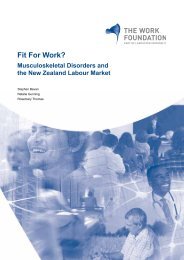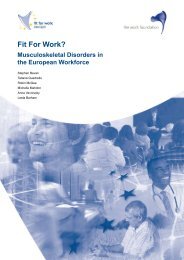FfW Bulgarian report (English language) - Fit for Work Europe
FfW Bulgarian report (English language) - Fit for Work Europe
FfW Bulgarian report (English language) - Fit for Work Europe
Create successful ePaper yourself
Turn your PDF publications into a flip-book with our unique Google optimized e-Paper software.
the beliefs that both parties have about the extent to which the work itself is (at least in part)<br />
caused by or related to the incapacity.<br />
There are numerous types of work-based intervention <strong>for</strong> assisting those with MSDs, ranging<br />
from ergonomic adjustments to providing access to physiotherapy, modifying work programmes<br />
to cognitive behavioural therapy, or a combination of various strategies. Evidence on the<br />
success of these interventions at tackling non-specific MSDs is mixed (Meijer et al., 2005). 53<br />
A systematic review of multidisciplinary treatments of patients with low back pain, <strong>for</strong> example,<br />
demonstrated that whilst the treatment improved function and decreased pain in individuals, it<br />
could not be demonstrated that this was linked to employees returning to work earlier than those<br />
who had not received it (Guzman, Esmail, Karjalainen, Malmivaara, Irvin et al., 2001). Whilst<br />
biomechanical or ergonomic factors may be related to the onset of back pain, evidence that<br />
interventions based on these principals will prevent re-occurrence or progression to chronicity<br />
is thin on the ground (Burton, 1997). In fact, it has proved virtually impossible to determine<br />
whether one treatment is significantly more effective than another (Ekberg, 1995). Even <strong>for</strong><br />
specific conditions such as RA, the evidence <strong>for</strong> the effectiveness of vocational rehabilitation is<br />
slim (Backman, 2004; de Buck, Schoones, Allaire and Vliet Vlieland, 2002).<br />
There is nonetheless broad agreement on the principles <strong>for</strong> managing non-specific MSDs,<br />
particularly back pain, that are outlined in Box 3 below. This includes advice and a number of<br />
relatively simple measures <strong>for</strong> employees and employers to follow on how to deal with back<br />
pain.<br />
Box 3: Principles of managing non-specific MSDs<br />
53 Findings from an evaluation of the effectiveness of return-to-work treatment programmes were inconsistent<br />
Interventions<br />
• Early treatment should be sought <strong>for</strong> back pain.<br />
• Most back pain is not due to a serious condition.<br />
• Simple back pain should be treated with basic pain killers and mobilisation.<br />
• It is important to keep active both to prevent and to treat back pain.<br />
• Getting back to work quickly helps prevent chronic back pain.<br />
• Adopt the correct posture while working.<br />
• All workplace equipment should be adjustable.<br />
• Take breaks from repetitive or prolonged tasks or postures.<br />
• Avoid manual handling and use lifting equipment where possible.<br />
• Clear in<strong>for</strong>mation should be provided to employees about back care.<br />
• Health and safety policies should be implemented to cover all aspects of day-to-day<br />
work and should be reviewed regularly.<br />
Source: Health and Safety Executive (2002)<br />
<strong>Fit</strong> For <strong>Work</strong>? 59







